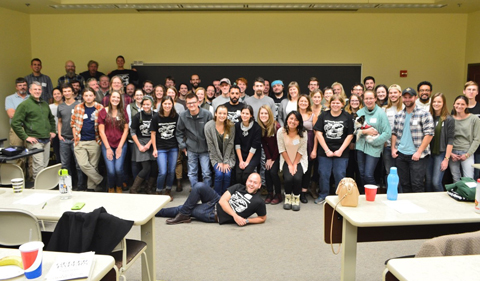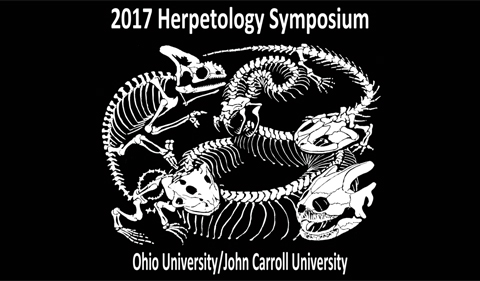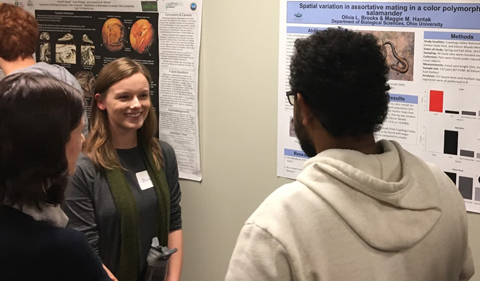
Participants at the 7th annual Ohio University/John Carol University Herpetology Symposium
Seven years ago, then-graduate student Vincent Farallo organized a symposium composed of Ohio University and John Carroll University undergraduates, graduate students, and faculty. The aim of the symposium was to bring together everyone interested in the biology of amphibians and reptiles, a field of biology known as “herpetology.”
The seventh annual OU/JCU Herpetology Symposium was held Nov. 11 at Ohio University.
Farallo, who was a graduate student in Biological Sciences at Ohio University, is now a postdoctoral fellow at Virginia Tech

T-shirt design for 2017, made by Dr. Chris Sheil, John Carol University
Since 2011, the herpetology symposium has alternated between OHIO and JCU in successive years. This symposium facilitates interaction between students and faculty from the two universities, and several students and faculty are now collaborating on research projects. Moreover, the symposium provides undergraduates and younger graduate students the opportunity to present their research in a small conference setting.
This year’s seventh annual OU/JCU symposium co-organized by graduate students Anthony Gilbert and Maggie Hantak, both in the Biological Sciences Department at Ohio University.
On Friday, Nov. 10, Dr. David Weisrock from the University of Kentucky gave a plenary lecture on his extraordinary research exploring the salamander genome. Whereas the human genome is around 3 billion base pairs in size, salamanders have genomes that can be up to 120 billion bases. Indeed, salamanders have some of the largest genomes known, and no salamander genome has ever been sequenced (by contrast, sequencing the human genome is routine).

Undergraduate Olivia Brooks presents her poster at the herpetology symposium. Brooks works with Maggie Hantak, a Ph.D. student in the Kuchta lab in the Biological Sciences Department.
The symposium was on Saturday, Nov. 11 and included a record 75 registered participants from Ohio University and John Carol University. Most of the day was filled with 15-minute talks, mostly by graduate students, on topics such as the impacts of climate change on reptiles, skin toxins in dart poison frogs, genetic structure in salamanders and snakes, and the conservation of amphibians and reptiles. The end of the day included a poster session, where graduate students and undergraduates presented their research.
Given the success of the symposium, it has already been decided that the eighth annual symposium will be held next fall at John Carol University.



















Comments